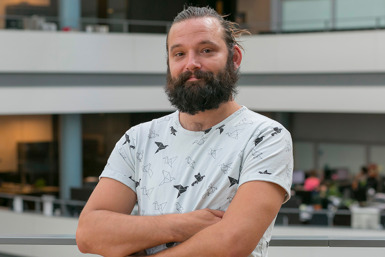Utrecht University Secures ERC Proof of Concept Grant for Pandemic Early Warning System
Glycoscientist Robert de Vries and his research associates have received a €150,000 Proof of Concept grant from the European Research Council (ERC). With this funding, De Vries and his colleagues will explore the feasibility of developing an early warning system for viruses at live animal markets in low-income countries. This system aims to detect animal viruses that have a high risk of switching to humans at an early stage. In theory, the technique could help prevent virus outbreaks or even pandemics.
Robert de Vries
In Cambodia and other Southeast Asian countries, markets where live animals are traded play a significant social and economic role. However, these markets are also hotspots for viruses, where birds carrying influenza viruses and bats carrying coronaviruses encounter other animal species and large groups of people.
Although these viruses typically reside in animals, there is a risk that they could eventually infect humans. For instance, the virus responsible for the COVID-19 pandemic initially spread among animals at a market in Wuhan, China.
We know that there is a good chance that the next pandemic is going to be caused by a flu virus. So, we simply have to take these precautions.
Robert de Vries
Receptors
But how can viruses jump to other hosts? Viruses use receptors—molecules on the surface of cells—to bind to and invade their host cells. Birds have different receptors than humans. Therefore, a flu virus circulating in birds would need to adapt to bind to human receptors to be able to infect humans.
De Vries and his partners use this knowledge to identify viruses that might be on the verge of jumping to humans. They aim to develop glass slides coated with receptors that are bound by avian viruses, receptors bound by human viruses, as well as receptors that fall somewhere in between.
Early warning
De Vries: “If the reading of such a glass slide shows that a bird virus from such a market now binds to a human receptor or an intermediate form, you know that the virus is evolving in an undesirable direction. It gives you an early warning, enabling you to act as soon as possible.”
It is still a wild idea. We are now going to investigate whether we can do it.
Robert de Vries
By acting quickly, it is possible to prevent outbreaks or even a pandemic. De Vries: “Before the COVID-19 pandemic, there was little interest in coronaviruses and not enough research was done on them. We know that there is a good chance that the next pandemic is going to be caused by a flu virus. So, we simply have to take these precautions.”
A wild idea
The researchers have received the grant to first demonstrate the feasibility of their method. De Vries: “It is still a wild idea. We are now going to investigate whether we can do it.”
Research partner Erik Karlsson is based in Cambodia. De Vries: “We already know a lot about flu and coronaviruses and we know we can create glass plates with receptors on them. Now, we need to test whether we can detect viruses in environmental samples that are not naturally clean. Erik sends us samples from Cambodia that do not contain viruses. We then add a virus to these samples and see if we can detect it in these ‘dirty, clean’ samples. If that works, we are well on our way.”
Simple and accessible
The company Innopsys is contributing to the project by developing a user-friendly device that allows the glass slides to be read easily on-site, even in a relatively humid environment. De Vries: “This way, we keep the data local and ensure that the laboratories there can continue their development.”

